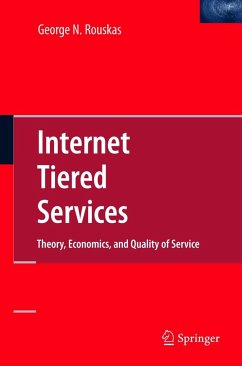This book provides a theoretical framework for reasoning about and pricing Internet tiered services, as well as a practical toolset for network providers to develop customized menus of service offerings. Internet service providers (ISPs) have introduced several forms of a tiered service, in which users may select from a small set of tiers that offer progressively higher levels of service with a corresponding increase in price. The material provides a comprehensive study of the design, sizing, pricing, and operation of Internet tiered services. It also addresses the following issues: optimization of service tier selection and sizing, economic models for optimal pricing of service tiers, models for optimizing "bundles of services", and applications of tiered services in simplifying important QoS functions in the network, including fair packet scheduling.
As telecommunications products and services have become an essential part of - eryday life, consumers have at the same time grown intimately familiar with the concept of tiered pricing that is associated with such services. With tiered service structures, users may select from a small set of tiers that offer progressively higher levels of service with a correspondingincrease in price. Tiered structures have been applied in several forms to wireless services (e. g. , characterized by the amount of voice minutes, number of text messages, or the size of one's circle of friends to whom voice calls are free), Internet broadband access (e. g. , the access speed or volume of monthly transferred data), and digital TV offerings (e. g. , the number of channels included), among others. Service tiering is a form of market segmentation which, if applied appropriately, bene ts both providers and consumers by making available services and associated price points that re ect the diversity in consumers' needs and ability to pay. The purpose of this book is to develop a theoretical framework for reasoning about and pricing Internet tiered services, as well as a practical algorithmic toolset fornetworkproviderstodevelopcustomizedmenusofserviceofferings. We provide a comprehensive study of the design, sizing, and pricing of tiered structures for - ternet services, and we illustrate their potential in simplifying the operation of c- plex components such as packet schedulers.
As telecommunications products and services have become an essential part of - eryday life, consumers have at the same time grown intimately familiar with the concept of tiered pricing that is associated with such services. With tiered service structures, users may select from a small set of tiers that offer progressively higher levels of service with a correspondingincrease in price. Tiered structures have been applied in several forms to wireless services (e. g. , characterized by the amount of voice minutes, number of text messages, or the size of one's circle of friends to whom voice calls are free), Internet broadband access (e. g. , the access speed or volume of monthly transferred data), and digital TV offerings (e. g. , the number of channels included), among others. Service tiering is a form of market segmentation which, if applied appropriately, bene ts both providers and consumers by making available services and associated price points that re ect the diversity in consumers' needs and ability to pay. The purpose of this book is to develop a theoretical framework for reasoning about and pricing Internet tiered services, as well as a practical algorithmic toolset fornetworkproviderstodevelopcustomizedmenusofserviceofferings. We provide a comprehensive study of the design, sizing, and pricing of tiered structures for - ternet services, and we illustrate their potential in simplifying the operation of c- plex components such as packet schedulers.








